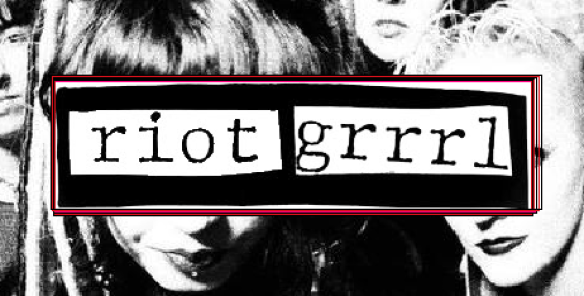Riot Grrrl
by Rowan Bagley

I first heard Bikini Kill’s “Rebel Girl” when I was 19. On one of the many nights I stayed awake well into the early hours of the morning, I found a playlist on Spotify titled “Essential Punk”. While I had listened to most of the songs on the playlist before, this song was unknown to me and had a sound like nothing I had ever heard before. The instruments had the harsh, almost fuzzy sound that I had come to associate with a lot of classic punk, but the lead singer was angrier than I had ever heard any other female lead be. Kathleen Hanna was shouting into the mic about revolution, but also about love. Specifically, loving other women. Having grown up in rural central Maine, I wasn’t aware that this was even a possibility in any kind of music.
The Riot Grrrl movement began in the 1990s as a punk subculture that wove feminist consciousness with the sounds and political messages of punk. Like the grunge era of the time, Riot Grrrl artists got their start in the Pacific Northwest and is often credited as being the start of the Third Wave feminist movement. What sets Riot Grrrl apart from other punk and grunge movements of the time was that it was also rooted in a DIY ethic, zines, art, political action, and activism.
Formed in 1990 in Olympia, Washington, Bikini Kill was one of the pioneering bands of the Riot Grrrl movement. The quartet wrote songs about domestic violence, sexuality, patriarchy, and classism while cultivating a female-oriented space at their shows. Punk was (and still is) a male-dominated music scene, and the group felt it was necessary to create an environment where women and members of the LGBTQ+ community could feel safe. The band designated space at the front of the venue they were playing at for women and Hanna, the lead singer, would often stage dive into the crowd to personally remove men she saw harassing women.
Despite being credited as one of the founding bands of Riot Grrrl, Bikini Kill has famously rejected media attention that put them at the center of the movement, even calling for a media blackout in 1994 when they felt the constant attention was putting them at the forefront. While Bikini Kill is one of the most easily recognizable bands of the era, many other groups took shape during the time, such as: Bratmobile, Babes in Toyland, Sleater-Kinney, and Heavens To Betsy.
Like many women who have aligned themselves with the punk movement, Bikini Kill was my introduction to the Riot Grrrl movement and responsible for my discovery of an entire genre of punk feminist music. While I’ve branched out since first hearing them, “Rebel Girl” and the ideals of revolution and female intimacy remain close to me.
https://www.nypl.org/blog/2013/06/19/riot-grrrl-movement
http://www.feministezine.com/feminist/music/The-History-of-Riot-Grrls-in-Music.html
Categories
